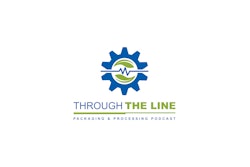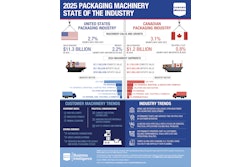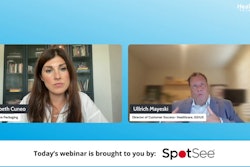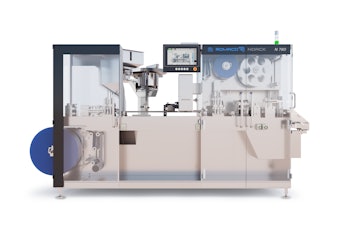A foray into advising manufacturers on proper lean methodologies in their operations grew into a book about lean manufacturing and building inclusive and diverse cultures. OEM Editor Stephanie Neil discusses the book “Steel Toes and Stilettos” with authors Kathy Miller and Shannon Karels, complete with advice for women on navigating a career in manufacturing. Often the pair felt gender played too large of a role in how their peers perceived them despite both serving in senior leadership roles at their respective companies.
To subscribe, rate, review and find more unPACKED podcast episodes, visit pmmi.org/podcast or find us on Apple podcasts, Spotify or iHeart Radio.
 | Read the full transcript below |
Stephanie Neil:
So welcome Kathy and Shannon. You are the authors of the book, Steel Toes and Stilettos. Such a fun title. Kathy, you want to tell me where that came from?
Kathy Miller:
Yeah, actually it was Shannon's brainchild. We were having a family visit and we decided that we had a good story and we wanted to write a book. It seemed like a great idea at the time. And you know how sometimes you have those ideas and then they just move away when you're not together anymore? By the next day, Shannon called me and said, "Hey, I've got a title for our book, Steel Toes and Stilettos." We had thought about things like, "In her Shoes," or those sorts of things. But the key thing is that the two are not mutually exclusive, right? You can wear safety shoes and be in, what's been a male dominated environment or industry, and still keep that authentic part of yourself that's female and that part of your identity. And so we think that those three simple words say it all.
Stephanie Neil:
They do. I love it. And I have been reading the book and there's a cute situation. I don't know if it's cute or funny, but it was a shoe situation. You want to tell us how you two met?
Kathy Miller:
So at the time we met, I was a global vice president of Lean Operations and Strategy Deployment. And I was traveling all over the world, the company had over 300 plants. And teaching and auditing and just helping move the organizations at the next level. Nine times out of 10, I was the only female on the trip when I was traveling with the business leaders, the group presidents, the lean transformation managers. And they were always challenging me to carry on my luggage. And I just hated that because I really appreciate my accessories, if the truth be known.
Kathy Miller:
So on this one particular trip up, I decided to take them on the challenge. And I did not pack my safety shoes because as you know, they're large and clunky and they take up a half of a carryon bag. So I ended up at Shannon's plant. I did not know Shannon at the time. And we went through all the preliminary presentations about the plant, how they were performing, what they were looking for help on.
Kathy Miller:
And it was time to go into the plant. And I said, "Because of these gentlemen in this conference room with me, I did not bring my safety shoes so I could carry on my luggage. So I'll need to borrow some." They said, "No, no problem." So we went to the lobby and opened a cabinet, and here were all sorts of men's safety shoes in all sizes. And so Shannon was walking through the lobby at the time and overheard this dilemma and very generously offered me her safety shoes. And fortuitously, we were the exact same size. And so we just really felt like that was the beginning of something special and magical. And that's how we first became friends and introduced.
Stephanie Neil:
But those are the situations that we don't really think about as women in manufacturing. But I mean, it happens and it's really. And I mean, Shannon, you were working in a plant, it's a male dominated industry. You're both working in it. And I do want to talk a little bit about your backgrounds as to how you got into this. Shannon, if you want to just give me a little glimpse of how you landed in manufacturing?
Shannon Karels:
Sure. By accident, I'll be honest. I actually was recruited out of college. I have a supply chain degree from Western Michigan University and I was recruited by this large company to be one of their first supply chain trainees, where you would spend two years in the program, you would move around to different divisions and learn all of the facets of that discipline. And so I ended up in the plants and I just fell in love with the process. I just loved being with all the people. I loved the various processes. I got to learn about how they make products. And then all of the ancillary things that go around with it. So how do you move material? How do you know that goes there? What happens next?
Shannon Karels:
And so that's where I kind of found my niche was in that material and information flow vibe is how I got into manufacturing. And then I stayed in the plants in all kinds of different supply chain functions. And then moved up into this lean transformation environment and world of where lean manufacturing was introduced to me. And that's how I met Kathy. And then I started running my own plant. From there, Kathy and I started our own business and another up here. So it was totally by accident, but I definitely fell in love with being in this manufacturing world.
Stephanie Neil:
And Kathy, do you have a similar backstory?
Kathy Miller:
I ended up in engineering because I needed to put myself through college and there was a program at Kettering University. It used to be called General Motors Institute or GMI Engineering and Management Institute. And their program was six months of working in a factory or business of some sort and six months of going to school. And so when you got out of college, you didn't have a lot of debt. So it was a very practical way to put myself through college. And I literally started working at the vehicle assembly plant at the age of 17 as an IE student.
Kathy Miller:
So it was quite an eyeopening experience. Very fascinating. I just found it amazing that every 60 seconds a functioning vehicle came off the end of that line. And I ended up leaving there and going to engineering when I started full-time, after graduating doing a stint in marketing. And then I just found that I really missed manufacturing. So I ended up going back out and working as a superintendent in pressure sensors and have stayed in and around the factories ever since.
Stephanie Neil:
So the book talks about this lean transformation success. This is what I love about this book. There's many layers to this story. It's about business. It's about lean transformation. It's about leadership. It's about women in manufacturing and it's about friendship. I'm just curious, Kathy, you hired Shannon to help lead a lean transformation. Is this what happened?
Kathy Miller:
I did. I did. So after I was the VP of Lean Enterprise for six years, I went and worked as a general manager to run a division and there were four plants in it. And at the time, no one on my staff was in charge of the lean transformation. So I posted the job and Shannon was one of very few people who applied for it because let's face it, who would want to work for the person who used to run Lean Manufacturing for the entire company?
Kathy Miller:
So we went through the interview process and Shannon was the leading candidate. And I fought really hard for her because she had a supply chain background, and there's so much about material and information flow that really underscores the success of a lean transformation. Yeah, she joined my team and was in charge of helping transform our plants and our office to a lean enterprise.
Stephanie Neil:
So you both had different leadership roles during this lean transformation. And I imagine you have different leadership styles. How did you support each other during this time?
Kathy Miller:
Yes, we definitely have very different personalities and we had different roles though at the time. So I was running the P&L and I was responsible for all of the functions within the division. It was an entrepreneurial division and you had responsibility for all the initiatives, all the functions and driving business results. So I had always been a pretty inclusive leader and how things always work with me is everybody at the table has a say. We debate things. I don't want, yes, people around me. I don't need people who are clones of me because then you get more diversity of thought and more creativity.
Kathy Miller:
So I brought Shannon into the role. Shannon, is an amazing person at taking the vision that's articulated and making it happen. And so I'm more of the strategy, big picture person. She's a person who can take that and turn it into reality. And over time we learned together how to get it to sustain itself with all of the people in the plants and the offices at the division. Shannon, I don't know if you want to add a little bit more color to that.
Shannon Karels:
Yeah, so it was very different. I had been a leader of people before taking on this role. But this was different because I had a couple people, lean engineers working for me, but this was more of a leadership role without authority. So I had to learn a completely different way to connect with people and get them to follow us and follow the vision and follow all the things and changes I was asking them to do. So that three years was a significant learning curve for me on what kind of leader I wanted to be. And Kathy was such a great role model for that because she created this safe culture that allowed us to be our authentic selves because she truly was and allowed us to fail and try again. And she celebrated our successes.
Shannon Karels:
And so when I left that role and started running the plants, I really took that leadership style with me. So I would say for me, it was just more of a learning experience. Now, we also learned how to work with each other personally and outside of our day to day job. So Kathylearned that I was my toughest critic and there's nothing she could have said if I messed up that could have made me feel any worse than I already did. So instead, she would just lift me up and support me and sometimes give me tough love and say, "Suck it and get back out there." And then I would help talk her off the ledge sometimes when all of the exterior pressures were coming down on her from that managerial standpoint. And I would try to help her put things into a little bit more perspective. So we just found this ebb and flow in this relationship that bonded us through the process.
Stephanie Neil:
All right. But so here's two women leading this effort. Did you get any resistance from the rest of the team, from the organization, especially maybe the men?
Kathy Miller:
There's always a certain level of resistance when you're trying to make a big transformation. I don't think any of it was really gender based. I think more of it was, "You're new to the organization. What do you about these types of processes? What do you know about our industry? What do you know about our customers?" So I think it would be more the people who had been running the plants there and the businesses there, because they had been there for a very long time. I never personally got the sense that there was a gender based issue to some of that.
Stephanie Neil:
So then, how is it that you do build trust among the team when you're implementing new processes and procedures? I guess it's more of your leadership styles and coming into a project and leading an effort. How do you get people on board and get them to trust that you're leading them in the right direction?
Kathy Miller:
Well, first of all, you have to articulate a vision in such a way that people can help see what you see when they've never actually experienced it before. And so it was well known the backgrounds that both Shannon and I had coming into that division and that we had had a lot of success in this area. If we're talking specifically about the lean transformation. But I articulated the vision, I never wavered from the vision and communicated it constantly, not only what we were going to do, but the progress that we were making. And I think the way that trust was really built was I spent a lot of time with people. So I spent a lot of time through the day trying to develop good connections with people to really listen to people, to get to know people, to understand what their challenges were. And then a lot of times I would do my corporate worker things at night.
Kathy Miller:
And I think just being out there, being vulnerable, being visible, being a good listener, and people started to really understand that I really cared about this operation and its long term success, which in turn supported them and their families. And it wasn't about me just moving through and moving up in the corporation. I really had a deep passion for the success of the business. And only by spending time with people, not only in the big communication meetings, but in one on in conversations, I think that trust got built.
Kathy Miller:
And when things went wrong, I really tried to make a very psychologically safe environment. And it wasn't about who did something wrong. It was what happened? How do we fix it? And how do we prevent it from happening again? It was never about who and command and control and punitive in nature. And I think over time, as people got to know Shannon and me and my entire staff, we all operated that way. Those were my vision and values and operating principles that I never wavered from, a lot of trust was built. And especially as we started to get some success and some good results and celebrate those, people really started to get a feel for how this change could make their lives better.
Stephanie Neil:
And Shannon, I mean, do you agree that this transparency, this communication, I mean, you were leading without all the authority that Kathy might have had? So did you approach it the same way?
Shannon Karels:
I did. I mean, I spent so much time on the floor with the people and observing the processes and working with my team to try to figure out ways to improve it. And we really were a team and it did take a lot of time. I mean, I had to learn how to influence people without that command and control type of role. So I had to talk. I talk to people all day, every day. "What do you think about this? Hey, I'm thinking about implementing this change, what are your thoughts?" And there were some people where you just had to learn how they handled change.
Shannon Karels:
And I had to learn that not everybody handles change the way that I do. So it took me a while to be able to get in that groove. And it was frustrating when people wouldn't jump right in line and think this was all a great idea. So I had to really fine tune my techniques on communication and understanding, how people deal with change and addressing them individually in most cases.
Shannon Karels:
And for a great example is we had a quality manager and I would go to him and say, "I would like to do this. And here's what I'm thinking. What do you think?" And he would share his ideas with me. And then I'd come back around sometime later and say, "Okay, here's what I found out." And I would tell him everything, "And this is what I want to do." And he would be the biggest advocate for it, but you had to prep him for the change.
Shannon Karels:
And so those were some major skills that I had to take on to be able to get people to trust me. And then again, if somebody told me something, the biggest thing I think that was impactful for, especially on the shop floor, was to go back to them and follow up. And say, "Hey, I know you told me this. It's a great idea. Here's what we're doing with it. Here's what we're going to implement when or why we can't." And that went a long way with people saying, "Oh, she actually does hear me."
Stephanie Neil:
So I do want to talk a little bit more about women in manufacturing. And I get the impression that you didn't really feel that you had to work harder to prove your ability as leaders because of your gender. Am I correct in assuming that?
Kathy Miller:
I'll speak for myself. I always worked hard, no matter what situation I was in, whether I was in school or at work. I didn't feel that I had to work hard because I was already working as hard as I could. I would say there were situations where I felt excluded. Even within the book, there were a few situations where there were corporate events that were hosted at country clubs that only allowed male membership to golf and things like that. And that's been within this decade and it seems a little bit hard to imagine. So there were times that I felt excluded, but I didn't feel like I could work any harder than I already was.
Kathy Miller:
And I think the issue that was bothersome to me, as a female in a male dominated world would be things that people would say to me that I think were compliments and well intended, but made me feel as though my accomplishments were being reduced to one aspect of my identity, which is my gender. Things like, "Oh, Kathy, you're a VP of ops. We've never had a female of VP of ops before." Or, "You're a female global director," when I would meet people. Those things would make it awkward or when we are having the inevitable diversity and inclusion discussions. And you'd be in a meeting and you'd be the only female in there. And they'd put up a pie chart of how many females they had at each level. Those things were very awkward.
Stephanie Neil:
Yeah. So these situations where you're being excluded, do you have advice for women considering a career in manufacturing or some aspects of this industry? Any advice you would offer to them about how to navigate these situations?
Kathy Miller:
I think the main thing is, be your authentic self. When people would make comments like that, that were awkward I would often make a joke just because it was so awkward to move on. But there's more female role models now than there were when I was growing up in this industry. So find someone that you can relate to and emulate how they get through awkward situations. They're not as often as they used to be. There's a lot more emphasis around diversity and inclusion. And so, most of the time now people realize what's appropriate to say and not to say in those sorts of things. But develop strong relationships with your peers, your bosses, the people around you, and be your authentic self. And you will shine through.
Shannon Karels:
I agree with Kathy completely. You can stay true to yourself and not conform to any stereotypes and still be successful. And I think that if you don't do that, you're going to get lost. I know I did a couple times and I had to figure out how to get back to my values and what was important to me and the type of leader I wanted to be. And so, yeah, you just need to stay true to yourself. And if you're coming in to this world, this manufacturing, they say male dominated industry, it's always about that. It's about finding where you add value and where your talents can help a team accompany yourself. And that's what's important is to just focus on being you and working hard and doing the job you want to do.
Stephanie Neil:
So before we wrap up, I do want to mention that you both now have a company called Op Sisters and real interested to hear what that's all about.
Shannon Karels:
Yeah. So actually Op Sisters was formed by Kathy and I, after we wrote the book, that's really what kick started us. And then we said as we got through this, "We would like to give back to the manufacturing community by expanding outside of the book. So maybe we can start working on advising manufacturers that are interested in using lean methodologies, as well as building inclusive and diverse cultures to do so." And then we are doing some speaking engagements and coaching, personal coaching all the way up from supervisory roles to executives and training. So we're offering how to implement these types of high performing inclusive cultures and lean transformations.
Stephanie Neil:
Yeah, I mean, right now that is such a huge initiative creating a culture of diversity and inclusion. And I mean, that must be a pretty rewarding type of business to be in right now, cultivating these types of cultures.
Kathy Miller:
100%. It's where my passion lies. And I'm not sure if I mentioned it a little bit earlier, but I went back to school last year and got a master's degree in applied positive psychology and learned a lot of the science behind inclusive cultures and helping people thrive. And so supplementing multiple decades of creating these inclusive cultures that got results, and then understanding the science behind them, it's just so exciting to go out and share that with other industries to help make them successful, and create strong organizations that are support people and their families.
Stephanie Neil:
Right. Well, we're running out of time, Steel Toes and Stilettos, where can our listeners get your book?
Shannon Karels:
At any major book retailer, Amazon, Routledge.com, Barnes & Noble. Or they can go to our website appsisters.com.
Stephanie Neil:
Excellent. Kathy and Shannon, thank you so much for sharing your story with us today. Really great conversation and everybody buy the book.
Kathy Miller:
Thank you so much.






![At the[PACK]out, presenting 'Wicked Stability: Predicting the Aging Degradation of Materials' were speakers (from left): Dan Burgess, Henk Blom, and Rod Patch w/ Moderator Seema Momin.](https://img.healthcarepackaging.com/files/base/pmmi/all/image/2022/05/Wicked_Stability.627af09af0762.png?auto=format%2Ccompress&fit=crop&h=167&q=70&w=250)















